Boxall
0 likes282 views
Pharmaceuticals are released into the environment through sewage sludge applied to agricultural soils. Studies have detected various pharmaceuticals in sewage sludge samples at concentrations that could potentially affect soil organisms. Laboratory studies show some pharmaceuticals can accumulate in earthworm tissues. Modeling indicates factors like a drug's properties, soil characteristics, and organism type influence bioaccumulation. While risks to human health are generally low, certain levels of pharmaceutical exposure may subtly affect non-target species like invertebrates through mechanisms related to a drug's mode of action. Further research is still needed to fully understand pharmaceutical impacts on terrestrial environments.
1 of 17



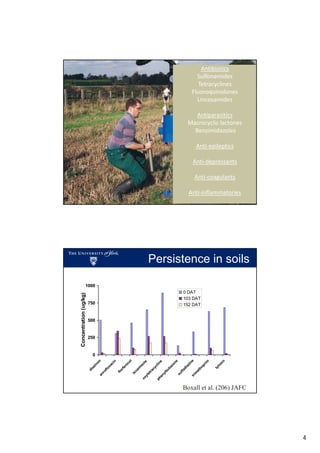

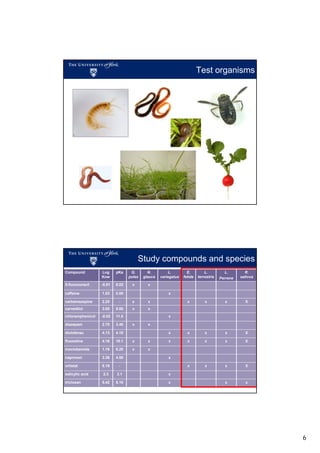
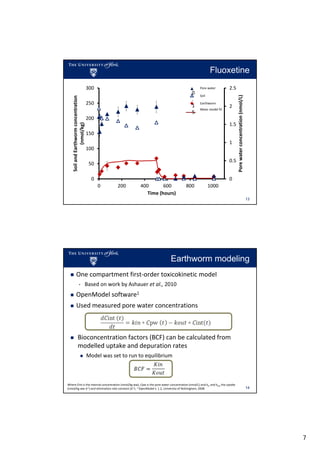

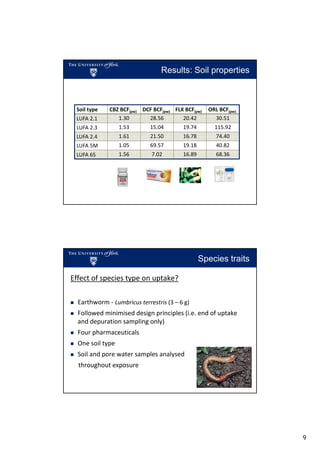
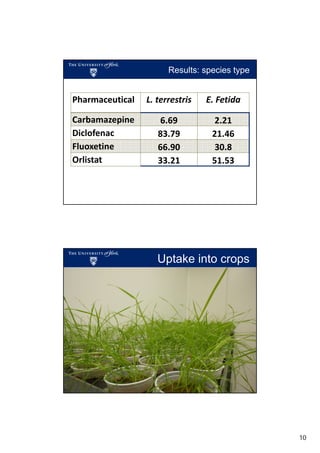


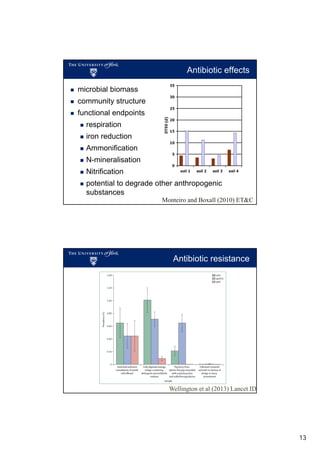
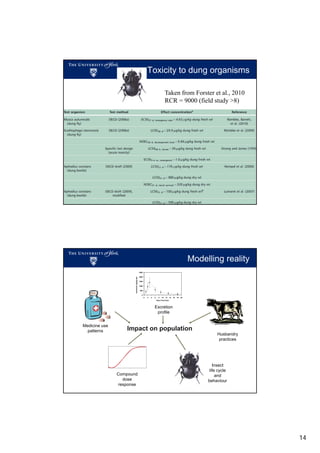

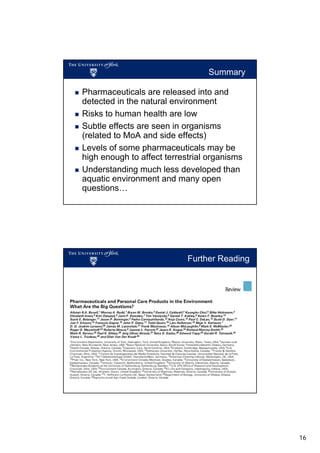
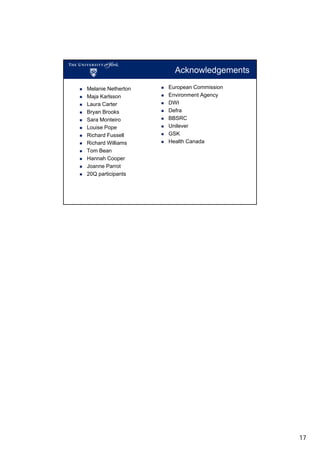
Ad
Recommended
pH meter Use, Calibration and application
pH meter Use, Calibration and applicationVeena Dongare
╠²
The document discusses pH meters and their uses. It introduces pH meters as potentiometric devices that can estimate hydrogen ion concentration in order to determine if a sample is acidic, basic, or neutral. pH meters have various applications, including acid-base titrations, pharmaceutical drug development, medical diagnosis, dairy production, agriculture, aquaculture, and assessing water quality. The document also provides background on pH, explaining that it was first defined in 1909 as a scale by the Danish scientist S├Ėren Peter Lauritz S├Ėrensen to quantify hydrogen ion concentration in solutions, which is important for enzymatic reactions in living systems.Advances in biopurification system for pesticide degradation ŌĆō chile ŌĆō maria ...
Advances in biopurification system for pesticide degradation ŌĆō chile ŌĆō maria ...ECOHUERTA
╠²
The document discusses advances in biopurification systems for pesticide degradation, focusing on factors that affect efficiency, such as biomixture composition, temperature, and microbial activity. It highlights various studies on the degradation rates of different pesticides in various soil compositions and the role of bacterial consortia, nutrients supplementation, and immobilization techniques on improving bioremediation. Additionally, it provides experimental data on the effectiveness of different materials and conditions in enhancing pesticide degradation in biobeds.K1 K. Straif
K1 K. StraifKate Jones
╠²
The document summarizes the work of the IARC Monographs Program in evaluating potential carcinogens. Over 950 agents have been evaluated, with 110 found to be carcinogenic to humans. National health agencies use the Monographs to prevent exposure to known or suspected carcinogens. Recent Monographs have increasingly incorporated mechanistic data to identify carcinogens, even in the absence of cancer studies. Future work includes further analyzing concordance between human and animal tumors, key carcinogenic mechanisms, and identifying priorities for evaluation using advisory groups.5.4 Menezes Filho
5.4 Menezes FilhoKate Jones
╠²
This document summarizes a study on the effects of high levels of airborne manganese exposure on children's behavior in Brazil. The study found:
1) Children living near a ferro-manganese alloy plant in Brazil had high levels of manganese in their hair, above EPA guidelines for air levels.
2) Higher manganese levels in children's hair were correlated with increased externalizing behaviors like aggression and disruptiveness based on parent reports.
3) After controlling for potential confounders, higher manganese levels were associated with higher scores on scales of aggression, disruptiveness, total externalizing behaviors, and inattention.
4) The results suggest that high airborne manganese exposure may negatively12.3 pirard
12.3 pirardKate Jones
╠²
This document summarizes the results of a study measuring levels of cadmium in urine and mercury in hair of 129 Belgian children ages 6-11 and their mothers. For cadmium, the main determinants of higher levels were age and living in an urban area. For mercury, higher levels correlated with greater fish consumption and more dental fillings. Most participants' cadmium and mercury levels were below health guidelines, though a small percentage exceeded some limits. The study also compared Belgian results to other European countries participating in the same monitoring program.B.1 Laitinen
B.1 LaitinenKate Jones
╠²
This study analyzed fire fighters' multiple exposures to perfluoroalkyl acids (PFCs) and 2-butoxyethanol found in aqueous film-forming foams (AFFFs). The study aimed to analyze PFC profiles in used foam, assess firefighter exposure, and evaluate eight AFFFs. Serum samples before and after training sessions found increased excretion of PFOA, PFNA, PFHxS, and PFOS in firefighters. Urinary samples also showed exposure to 2-butoxyethanol exceeding limits for the general population. The study concluded that firefighter exposure to PFCs was higher than the general population and increased during training. PFHxS showed the highest increase, making it13.2 M. Bader
13.2 M. BaderKate Jones
╠²
1) Biomonitoring is a versatile tool for assessing chemical exposures during maintenance work and incidents in the chemical industry. It can be used for regular surveillance and targeted monitoring of individuals.
2) A case study describes biomonitoring of workers during a steamcracker shutdown, finding elevated benzene biomarkers in some workers that declined over the shutdown period.
3) Biomonitoring after a pyraclostrobin smoldering incident distinguished exposed from non-exposed emergency responders and found elevated p-chloroaniline levels in some workers that declined over time.6.2 schettgen
6.2 schettgenKate Jones
╠²
This study developed a method to simultaneously quantify the mercapturic acids of acrylonitrile (CEMA) and its genotoxic metabolite cyanoethylene-epoxide (CHEMA) in human urine. The method was applied in a pilot human biomonitoring study with 47 non-smokers and 36 smokers. Smokers had significantly higher levels of both metabolites, with CEMA levels correlated to cigarette consumption. CHEMA was detectable in 90% of smokers and accounted for about 13% of total mercapturic acid levels, indicating oxidative metabolism. The method allows estimation of background and smoking-related acrylonitrile exposure and its genotoxic potential in humans.Bio indication of Heavy metals
Bio indication of Heavy metals bhanu prakash
╠²
This document summarizes the results of several studies that measured heavy metal concentrations in soil, water, and plant samples from different locations. The studies analyzed the effects of heavy metals like cadmium, lead, chromium, nickel, and zinc on the growth of plants and microorganisms. The summaries include tables showing heavy metal concentrations found in samples and the effects on parameters like microbial survival, plant yield and growth.Heavy Metals Soil Evaluation in Cuba, a case study
Heavy Metals Soil Evaluation in Cuba, a case studyExternalEvents
╠²
This document evaluates heavy metal contamination in Cuban soils, emphasizing the importance of monitoring for food safety and agricultural product certification. It details sources of heavy metals, sampling methods, and provides reference values based on analytical techniques to assess risks. The Cuban soil service is developing a preliminary methodology for evaluating these contaminants to safeguard soil quality for future generations.Microbial bioremediation
Microbial bioremediationvarunparmar18
╠²
The document discusses microbe-mediated bioremediation as a solution for soil pollution caused by industrial activities, pesticide misuse, and waste disposal. It outlines the types of bioremediation techniques, such as mycoremediation and microbial bioremediation, and stresses the importance of maintaining soil quality for life sustainability. The conclusion emphasizes the urgent need for environmentally friendly remediation strategies to restore polluted soils and preserve natural resources.SOIL CARBON DYNAMICS UNDER INTENSIVE CROPPING SYSTEM
SOIL CARBON DYNAMICS UNDER INTENSIVE CROPPING SYSTEMVasantrao Nail Marathwada Krishi Vidyapeeth, Parbhani
╠²
The seminar discusses the critical role of soil carbon dynamics in intensive cropping systems, highlighting soil as the largest carbon reservoir in terrestrial ecosystems and its importance in the global carbon cycle and climate change mitigation. It emphasizes the significance of soil organic carbon (SOC) and soil inorganic carbon (SIC) in determining soil health, fertility, and ecosystem functions. Various studies and data on carbon stocks, management effects on soil quality, and carbon turnover are presented to illustrate the impacts of agricultural practices on soil carbon dynamics.BEHAVIOUR OF HEAVY METALS IN SEWAGE-SLUDGE AMENDED SOIL
BEHAVIOUR OF HEAVY METALS IN SEWAGE-SLUDGE AMENDED SOILP.K. Mani
╠²
Heavy metals in sewage sludge-amended soils can impact food safety when crops uptake the metals. The document discusses:
1) Heavy metal concentrations vary in soils depending on soil properties like pH, organic matter and clay content which influence metal availability.
2) Uptake by plants depends on plant species and cultivars, with some accumulating more metals than others.
3) The transfer coefficient measuring the relationship between soil metal concentrations and levels in plants can identify risks of food contamination. Managing soil properties and plant selection are important for limiting metal uptake into the food chain.1 integrated nutrient management in various agroecosystems in tropics
1 integrated nutrient management in various agroecosystems in tropicsVivekananda Global University, Jaipur, Rajasthan -303012
╠²
The document discusses integrated nutrient management (INM) in tropical agroecosystems, highlighting the negative effects of continuous chemical fertilization on soil health and crop productivity. It emphasizes the importance of balanced fertilizer application and the role of organic inputs, bio-fertilizers, and sustainable practices in enhancing soil productivity. Various treatments and their impact on soil properties and crop yields are also presented, demonstrating the effectiveness of INM strategies.Impact of carbon sequestration on soil and crop productivity
Impact of carbon sequestration on soil and crop productivityPravash Chandra Moharana
╠²
This document discusses the impact of carbon sequestration on soil and crop productivity. It provides background on global carbon emissions and pools. Soil acts as both a source and sink of atmospheric carbon through processes like photosynthesis, respiration, and decomposition. Improving soil organic carbon through practices like conservation tillage, cover crops, nutrient management, and agroforestry can increase crop yields by improving soil quality properties. Maintaining or increasing soil organic carbon levels through appropriate land management practices helps mitigate climate change while enhancing soil health and agricultural productivity.Soil carbon sequestration
Soil carbon sequestration varunparmar18
╠²
This document provides a summary of a credit seminar presentation on climate change. The summary includes:
1. The seminar was presented by Varun Parmar from the Department of Soil Science at CSK HPKV Palampur on climate change topics including rising global temperatures, increasing greenhouse gas emissions, impacts on agriculture, and potential solutions focused on increasing soil carbon sequestration.
2. Solutions discussed included nutrient management, reduced tillage, crop rotation, agroforestry, and biochar which can increase soil organic carbon and mitigate climate change through carbon sequestration. Data was presented showing increases in soil carbon and crop yields with these practices.
3. Increasing soil carbon throughMercury in soil-plant-human system and its remediation
Mercury in soil-plant-human system and its remediationJyotirmay Roy
╠²
The document discusses the biogeochemistry of mercury in the soil-plant-human system, highlighting its sources, pollution levels, and health effects, particularly focusing on the status of mercury contamination in Indian soil. It outlines the mercury transformation processes and the risk assessment for both ecological and human health due to mercury exposure from contaminated environments. Additionally, it presents various remediation techniques for mercury-contaminated materials and soils to mitigate its toxic impact.Nutrient management in kharif fodder crops.pptx
Nutrient management in kharif fodder crops.pptxanju bala
╠²
The document discusses nutrient management practices for kharif fodder crops in India, emphasizing the importance of livestock production for agriculture and rural income. It identifies major constraints like inadequate grazing management, poor nutrient practices, and insufficient cultivation areas, while proposing strategies for improvement including agronomic management and use of biofertilizers. Research findings presented in various tables detail the effects of different nutrient levels and management techniques on fodder yield and quality, highlighting the significance of balanced fertilization.SOIL ORGANIC CARBON DYNAMICS: IMPACT OF LAND USE CHANGES AND MANAGEMENT PRACT...
SOIL ORGANIC CARBON DYNAMICS: IMPACT OF LAND USE CHANGES AND MANAGEMENT PRACT...University of Agricultural and Horticultural Sciences, Shivamogga, Karnataka, India
╠²
The document discusses soil organic carbon (SOC) dynamics, emphasizing the impact of land use changes and agricultural management practices on SOC levels across various ecosystems. It details the fractions of SOC, factors affecting its dynamics, and comparative studies on SOC concentration in different land-use types in India. The findings highlight the importance of managing land use to enhance SOC, which plays a crucial role in agricultural sustainability and carbon cycling.Integrated nutrient management in wheat.ppt
Integrated nutrient management in wheat.ppttarun197873
╠²
The document discusses the significance of Integrated Nutrient Management (INM) in enhancing wheat yield and productivity, particularly in India and Gujarat, where low productivity is attributed to inadequate irrigation and imbalanced fertilizer use. It provides an analysis of various research findings on the effects of different nutrient treatments, including organic and inorganic fertilizers, on wheat yield and economics. Overall, INM is portrayed as a critical approach to improving soil health and achieving sustainable agricultural practices.Soil BioTechnology
Soil BioTechnologyMayank Rungta
╠²
This document summarizes the work of Prof. H.S. Shankar of the Department of Chemical Engineering at IIT Bombay on soil biotechnology. Some key points:
1) Soil biotechnology uses microorganisms and biochemical processes to purify water, process solid wastes for agriculture, and enhance crop yields in a sustainable manner.
2) Experiments show that multi-stage water purification systems using microbial reactors can effectively treat sewage water.
3) Earthworms and other organisms play an important role in processing organic wastes in the soil and increasing nutrient availability for plant growth.
4) Studies of the carbon cycle, nitrogen fixation, photosynthesis, and other biochemical reactionsSeminar.silicon
Seminar.siliconRanjita Brahma
╠²
Silicon, a crucial element discovered by Jons Jacob Berzelius in 1824, is the second most abundant element in the Earth's crust and plays a significant role in enhancing plant resistance to stressors. It is used as a beneficial or quasi-essential element in agriculture, improving crop yield and quality while mitigating diseases and insect damage. Various sources of silicon, including slag-based fertilizers and biochar, are important for increasing soil silicon availability and supporting plant health.EFFECT OF COATED NITROGENOUS FERTILIZERS ON CARBON FRACTIONS IN RICE BASED CR...
EFFECT OF COATED NITROGENOUS FERTILIZERS ON CARBON FRACTIONS IN RICE BASED CR...P.K. Mani
╠²
The document investigates the impact of coated nitrogenous fertilizers on carbon fractions within rice-based cropping systems, emphasizing the decline of soil health and nutrient deficiencies in the Indo-Gangetic plains. The study involves various cropping sequences, such as rice-rice and rice-wheat, and evaluates the effectiveness of different nutrient management strategies, including organic additions. It also details the methodologies used for analyzing soil properties, aiming to enhance nutrient use efficiency and maintain productivity in these agricultural systems.Zn ppt on metal toxicity in phaseolus vulgarispresent.pptx
Zn ppt on metal toxicity in phaseolus vulgarispresent.pptxShaishavee S Kanojia
╠²
This document studies the impact of zinc (Zn) on the growth and biochemical parameters of Phaseolus vulgaris (common bean) seedlings, highlighting its essential role in nitrogen assimilation and stress response. Results indicate that low Zn concentrations enhance growth and chlorophyll content, while higher concentrations lead to toxicity and reduced seedling vigor. The findings underscore the necessity of balancing Zn levels to optimize plant health and crop yield.effect of essential micronutreints present - Copy.pptx
effect of essential micronutreints present - Copy.pptxShaishavee S Kanojia
╠²
The study investigates the effects of essential micronutrients zinc (Zn) and nickel (Ni) on nitrogen assimilation enzymes and stress-related parameters in Phaseolus vulgaris seedlings. Results indicate that Zn is vital for plant growth, with optimal concentrations necessary for physiological functions, while Ni serves as a crucial cofactor in nitrogen metabolism. The findings emphasize the balance required between micronutrient deficiency and toxicity to enhance crop yield and agricultural sustainability.Agronomic biofortification of crops with zinc and iron by Vajinder Pal Kalra
Agronomic biofortification of crops with zinc and iron by Vajinder Pal Kalravajinder kalra
╠²
1) Agronomic biofortification involves applying zinc and iron containing fertilizers to soil and plant leaves to increase the micronutrient content of food crops. Over 2 billion people worldwide are deficient in zinc and iron.
2) Common staple crops like rice and wheat naturally contain low amounts of zinc (10-40 mg/kg) which is insufficient to meet human zinc requirements. Applying zinc fertilizers can increase the zinc content of crop grains to 40-60 mg/kg.
3) Field studies found that applying zinc through soil or foliar methods increased the zinc concentration in wheat and maize grains compared to no zinc application. Combined soil and foliar application resulted in highest zinc concentrations.Application of biochar in agriculture.pptx
Application of biochar in agriculture.pptxBidhan Chandra Krishi Viswavidyalaya
╠²
The document discusses the application of biochar in agriculture, highlighting its potential benefits for soil health amid global agricultural challenges such as climate change and soil degradation. Biochar, produced through pyrolysis, enhances soil properties, promotes nutrient retention, and increases moisture and carbon content, which may improve crop productivity. The summary also emphasizes the importance of feedstock quality, production temperature, and soil conditions in optimizing biochar's effectiveness in agricultural practices.Effect of raw materials and methods on quality and process of composting.
Effect of raw materials and methods on quality and process of composting.Tamilnadu agricultural university
╠²
The seminar focuses on the quality of organic manures influenced by various methods and substrates, emphasizing the importance of composting in soil health. It presents detailed data on crop residue generation in India and discusses different composting techniques and their effects on compost quality and nutrient composition. Additionally, the document reviews factors affecting composting processes and outcomes from various studies on composting methods and their efficiencies.More Related Content
Similar to Boxall (20)
Bio indication of Heavy metals
Bio indication of Heavy metals bhanu prakash
╠²
This document summarizes the results of several studies that measured heavy metal concentrations in soil, water, and plant samples from different locations. The studies analyzed the effects of heavy metals like cadmium, lead, chromium, nickel, and zinc on the growth of plants and microorganisms. The summaries include tables showing heavy metal concentrations found in samples and the effects on parameters like microbial survival, plant yield and growth.Heavy Metals Soil Evaluation in Cuba, a case study
Heavy Metals Soil Evaluation in Cuba, a case studyExternalEvents
╠²
This document evaluates heavy metal contamination in Cuban soils, emphasizing the importance of monitoring for food safety and agricultural product certification. It details sources of heavy metals, sampling methods, and provides reference values based on analytical techniques to assess risks. The Cuban soil service is developing a preliminary methodology for evaluating these contaminants to safeguard soil quality for future generations.Microbial bioremediation
Microbial bioremediationvarunparmar18
╠²
The document discusses microbe-mediated bioremediation as a solution for soil pollution caused by industrial activities, pesticide misuse, and waste disposal. It outlines the types of bioremediation techniques, such as mycoremediation and microbial bioremediation, and stresses the importance of maintaining soil quality for life sustainability. The conclusion emphasizes the urgent need for environmentally friendly remediation strategies to restore polluted soils and preserve natural resources.SOIL CARBON DYNAMICS UNDER INTENSIVE CROPPING SYSTEM
SOIL CARBON DYNAMICS UNDER INTENSIVE CROPPING SYSTEMVasantrao Nail Marathwada Krishi Vidyapeeth, Parbhani
╠²
The seminar discusses the critical role of soil carbon dynamics in intensive cropping systems, highlighting soil as the largest carbon reservoir in terrestrial ecosystems and its importance in the global carbon cycle and climate change mitigation. It emphasizes the significance of soil organic carbon (SOC) and soil inorganic carbon (SIC) in determining soil health, fertility, and ecosystem functions. Various studies and data on carbon stocks, management effects on soil quality, and carbon turnover are presented to illustrate the impacts of agricultural practices on soil carbon dynamics.BEHAVIOUR OF HEAVY METALS IN SEWAGE-SLUDGE AMENDED SOIL
BEHAVIOUR OF HEAVY METALS IN SEWAGE-SLUDGE AMENDED SOILP.K. Mani
╠²
Heavy metals in sewage sludge-amended soils can impact food safety when crops uptake the metals. The document discusses:
1) Heavy metal concentrations vary in soils depending on soil properties like pH, organic matter and clay content which influence metal availability.
2) Uptake by plants depends on plant species and cultivars, with some accumulating more metals than others.
3) The transfer coefficient measuring the relationship between soil metal concentrations and levels in plants can identify risks of food contamination. Managing soil properties and plant selection are important for limiting metal uptake into the food chain.1 integrated nutrient management in various agroecosystems in tropics
1 integrated nutrient management in various agroecosystems in tropicsVivekananda Global University, Jaipur, Rajasthan -303012
╠²
The document discusses integrated nutrient management (INM) in tropical agroecosystems, highlighting the negative effects of continuous chemical fertilization on soil health and crop productivity. It emphasizes the importance of balanced fertilizer application and the role of organic inputs, bio-fertilizers, and sustainable practices in enhancing soil productivity. Various treatments and their impact on soil properties and crop yields are also presented, demonstrating the effectiveness of INM strategies.Impact of carbon sequestration on soil and crop productivity
Impact of carbon sequestration on soil and crop productivityPravash Chandra Moharana
╠²
This document discusses the impact of carbon sequestration on soil and crop productivity. It provides background on global carbon emissions and pools. Soil acts as both a source and sink of atmospheric carbon through processes like photosynthesis, respiration, and decomposition. Improving soil organic carbon through practices like conservation tillage, cover crops, nutrient management, and agroforestry can increase crop yields by improving soil quality properties. Maintaining or increasing soil organic carbon levels through appropriate land management practices helps mitigate climate change while enhancing soil health and agricultural productivity.Soil carbon sequestration
Soil carbon sequestration varunparmar18
╠²
This document provides a summary of a credit seminar presentation on climate change. The summary includes:
1. The seminar was presented by Varun Parmar from the Department of Soil Science at CSK HPKV Palampur on climate change topics including rising global temperatures, increasing greenhouse gas emissions, impacts on agriculture, and potential solutions focused on increasing soil carbon sequestration.
2. Solutions discussed included nutrient management, reduced tillage, crop rotation, agroforestry, and biochar which can increase soil organic carbon and mitigate climate change through carbon sequestration. Data was presented showing increases in soil carbon and crop yields with these practices.
3. Increasing soil carbon throughMercury in soil-plant-human system and its remediation
Mercury in soil-plant-human system and its remediationJyotirmay Roy
╠²
The document discusses the biogeochemistry of mercury in the soil-plant-human system, highlighting its sources, pollution levels, and health effects, particularly focusing on the status of mercury contamination in Indian soil. It outlines the mercury transformation processes and the risk assessment for both ecological and human health due to mercury exposure from contaminated environments. Additionally, it presents various remediation techniques for mercury-contaminated materials and soils to mitigate its toxic impact.Nutrient management in kharif fodder crops.pptx
Nutrient management in kharif fodder crops.pptxanju bala
╠²
The document discusses nutrient management practices for kharif fodder crops in India, emphasizing the importance of livestock production for agriculture and rural income. It identifies major constraints like inadequate grazing management, poor nutrient practices, and insufficient cultivation areas, while proposing strategies for improvement including agronomic management and use of biofertilizers. Research findings presented in various tables detail the effects of different nutrient levels and management techniques on fodder yield and quality, highlighting the significance of balanced fertilization.SOIL ORGANIC CARBON DYNAMICS: IMPACT OF LAND USE CHANGES AND MANAGEMENT PRACT...
SOIL ORGANIC CARBON DYNAMICS: IMPACT OF LAND USE CHANGES AND MANAGEMENT PRACT...University of Agricultural and Horticultural Sciences, Shivamogga, Karnataka, India
╠²
The document discusses soil organic carbon (SOC) dynamics, emphasizing the impact of land use changes and agricultural management practices on SOC levels across various ecosystems. It details the fractions of SOC, factors affecting its dynamics, and comparative studies on SOC concentration in different land-use types in India. The findings highlight the importance of managing land use to enhance SOC, which plays a crucial role in agricultural sustainability and carbon cycling.Integrated nutrient management in wheat.ppt
Integrated nutrient management in wheat.ppttarun197873
╠²
The document discusses the significance of Integrated Nutrient Management (INM) in enhancing wheat yield and productivity, particularly in India and Gujarat, where low productivity is attributed to inadequate irrigation and imbalanced fertilizer use. It provides an analysis of various research findings on the effects of different nutrient treatments, including organic and inorganic fertilizers, on wheat yield and economics. Overall, INM is portrayed as a critical approach to improving soil health and achieving sustainable agricultural practices.Soil BioTechnology
Soil BioTechnologyMayank Rungta
╠²
This document summarizes the work of Prof. H.S. Shankar of the Department of Chemical Engineering at IIT Bombay on soil biotechnology. Some key points:
1) Soil biotechnology uses microorganisms and biochemical processes to purify water, process solid wastes for agriculture, and enhance crop yields in a sustainable manner.
2) Experiments show that multi-stage water purification systems using microbial reactors can effectively treat sewage water.
3) Earthworms and other organisms play an important role in processing organic wastes in the soil and increasing nutrient availability for plant growth.
4) Studies of the carbon cycle, nitrogen fixation, photosynthesis, and other biochemical reactionsSeminar.silicon
Seminar.siliconRanjita Brahma
╠²
Silicon, a crucial element discovered by Jons Jacob Berzelius in 1824, is the second most abundant element in the Earth's crust and plays a significant role in enhancing plant resistance to stressors. It is used as a beneficial or quasi-essential element in agriculture, improving crop yield and quality while mitigating diseases and insect damage. Various sources of silicon, including slag-based fertilizers and biochar, are important for increasing soil silicon availability and supporting plant health.EFFECT OF COATED NITROGENOUS FERTILIZERS ON CARBON FRACTIONS IN RICE BASED CR...
EFFECT OF COATED NITROGENOUS FERTILIZERS ON CARBON FRACTIONS IN RICE BASED CR...P.K. Mani
╠²
The document investigates the impact of coated nitrogenous fertilizers on carbon fractions within rice-based cropping systems, emphasizing the decline of soil health and nutrient deficiencies in the Indo-Gangetic plains. The study involves various cropping sequences, such as rice-rice and rice-wheat, and evaluates the effectiveness of different nutrient management strategies, including organic additions. It also details the methodologies used for analyzing soil properties, aiming to enhance nutrient use efficiency and maintain productivity in these agricultural systems.Zn ppt on metal toxicity in phaseolus vulgarispresent.pptx
Zn ppt on metal toxicity in phaseolus vulgarispresent.pptxShaishavee S Kanojia
╠²
This document studies the impact of zinc (Zn) on the growth and biochemical parameters of Phaseolus vulgaris (common bean) seedlings, highlighting its essential role in nitrogen assimilation and stress response. Results indicate that low Zn concentrations enhance growth and chlorophyll content, while higher concentrations lead to toxicity and reduced seedling vigor. The findings underscore the necessity of balancing Zn levels to optimize plant health and crop yield.effect of essential micronutreints present - Copy.pptx
effect of essential micronutreints present - Copy.pptxShaishavee S Kanojia
╠²
The study investigates the effects of essential micronutrients zinc (Zn) and nickel (Ni) on nitrogen assimilation enzymes and stress-related parameters in Phaseolus vulgaris seedlings. Results indicate that Zn is vital for plant growth, with optimal concentrations necessary for physiological functions, while Ni serves as a crucial cofactor in nitrogen metabolism. The findings emphasize the balance required between micronutrient deficiency and toxicity to enhance crop yield and agricultural sustainability.Agronomic biofortification of crops with zinc and iron by Vajinder Pal Kalra
Agronomic biofortification of crops with zinc and iron by Vajinder Pal Kalravajinder kalra
╠²
1) Agronomic biofortification involves applying zinc and iron containing fertilizers to soil and plant leaves to increase the micronutrient content of food crops. Over 2 billion people worldwide are deficient in zinc and iron.
2) Common staple crops like rice and wheat naturally contain low amounts of zinc (10-40 mg/kg) which is insufficient to meet human zinc requirements. Applying zinc fertilizers can increase the zinc content of crop grains to 40-60 mg/kg.
3) Field studies found that applying zinc through soil or foliar methods increased the zinc concentration in wheat and maize grains compared to no zinc application. Combined soil and foliar application resulted in highest zinc concentrations.Application of biochar in agriculture.pptx
Application of biochar in agriculture.pptxBidhan Chandra Krishi Viswavidyalaya
╠²
The document discusses the application of biochar in agriculture, highlighting its potential benefits for soil health amid global agricultural challenges such as climate change and soil degradation. Biochar, produced through pyrolysis, enhances soil properties, promotes nutrient retention, and increases moisture and carbon content, which may improve crop productivity. The summary also emphasizes the importance of feedstock quality, production temperature, and soil conditions in optimizing biochar's effectiveness in agricultural practices.Effect of raw materials and methods on quality and process of composting.
Effect of raw materials and methods on quality and process of composting.Tamilnadu agricultural university
╠²
The seminar focuses on the quality of organic manures influenced by various methods and substrates, emphasizing the importance of composting in soil health. It presents detailed data on crop residue generation in India and discusses different composting techniques and their effects on compost quality and nutrient composition. Additionally, the document reviews factors affecting composting processes and outcomes from various studies on composting methods and their efficiencies.SOIL CARBON DYNAMICS UNDER INTENSIVE CROPPING SYSTEM
SOIL CARBON DYNAMICS UNDER INTENSIVE CROPPING SYSTEMVasantrao Nail Marathwada Krishi Vidyapeeth, Parbhani
╠²
1 integrated nutrient management in various agroecosystems in tropics
1 integrated nutrient management in various agroecosystems in tropicsVivekananda Global University, Jaipur, Rajasthan -303012
╠²
SOIL ORGANIC CARBON DYNAMICS: IMPACT OF LAND USE CHANGES AND MANAGEMENT PRACT...
SOIL ORGANIC CARBON DYNAMICS: IMPACT OF LAND USE CHANGES AND MANAGEMENT PRACT...University of Agricultural and Horticultural Sciences, Shivamogga, Karnataka, India
╠²
Effect of raw materials and methods on quality and process of composting.
Effect of raw materials and methods on quality and process of composting.Tamilnadu agricultural university
╠²
More from Kate Jones (20)
Wendy Jones Loughborough University
Wendy Jones Loughborough UniversityKate Jones
╠²
Working safely with Nanomaterials in R&D laboratories: an update.Pieter van Broekhuizen IVAM
Pieter van Broekhuizen IVAMKate Jones
╠²
Working safely with Nanomaterials in R&D laboratories: an update.John Mackenzie Thomas Swan
John Mackenzie Thomas SwanKate Jones
╠²
Working safely with Nanomaterials in R&D laboratories: an update.Claire Wienburg University of Bristol
Claire Wienburg University of BristolKate Jones
╠²
Working safely with Nanomaterials in R&D laboratories: an update.Stewart Kowalczyk
Stewart KowalczykKate Jones
╠²
This document summarizes research on the disposal and impacts of chlorinated solvents in a local community. It finds that up to 6.8 ppb of chlorinated benzene was found in 26 homes near known disposal sites for chlorinated solvents. Testing of residents found elevated levels of urinary markers indicating early kidney dysfunction in over half of participants, though follow up testing showed improvement. While exposure to chlorinated benzene can cause kidney damage, other pollution sources may have also contributed to local renal disease rates. The document reviews the toxicology of chlorinated benzene and differences in risk assessments between regulatory agencies.Kalin
KalinKate Jones
╠²
This document discusses the use of comprehensive two-dimensional gas chromatography with time-of-flight mass spectrometry (GCxGC TOFMS) for environmental forensics analysis. It introduces GCxGC TOFMS, describing how it provides improved separation of compounds compared to traditional GC. Applications discussed include analysis of polychlorinated biphenyls (PCBs) in bird tissues to determine geographic origin, and analysis of polycyclic aromatic hydrocarbons (PAHs) in coal tar samples to identify the type of distillation process and determine the source. Statistical methods are applied to GCxGC TOFMS data from coal tar samples to accurately classify unknown samples. The document concludes the technique is effective for environmental forensicsPaton
PatonKate Jones
╠²
This document discusses fractionating hydrocarbons for hazard and risk assessment through chemical and biological analysis. It describes extracting oil from contaminated soils and peat for analysis, and using extraction, fractionation, and indicator compounds to assess risks to human health and the environment from weathered petroleum hydrocarbons. Biological assays on the extracts include tests with microbes, plants, earthworms, and models to predict human and environmental exposure and toxicity.Stuart
StuartKate Jones
╠²
This document summarizes emerging organic groundwater contaminants and their transformation products. It defines emerging contaminants as anthropogenic organic compounds and their transformation products that are increasingly detected due to changes in chemical use, advances in analysis, and improved monitoring. Many emerging contaminants come from sources like wastewater discharge, manure/sludge application, and septic tanks. Common emerging contaminant groups discussed include pesticides, pharmaceuticals, personal care products, industrial compounds, and hormones. The document examines the pathways these contaminants take to groundwater and the processes controlling their subsurface migration. It also provides examples of specific contaminants frequently detected in UK groundwater and discusses their degradation.Weber
WeberKate Jones
╠²
The document summarizes the development of the Environmental Fate Simulator (EFS), a tool being created by the US Environmental Protection Agency to predict the degradation pathways of organic chemicals in groundwater. The EFS will integrate process science, cheminformatics applications, and modeling software to provide physicochemical properties and simulate reaction pathways of chemicals in various environmental media and conditions. It is being developed to help evaluate thousands of chemicals where limited data currently exists. The EFS will automate the simulation of chemical fate through various environmental scenarios to support exposure and risk assessments.10.4 Rossbach
10.4 RossbachKate Jones
╠²
- The study examined the uptake and elimination of permethrin in 30 male volunteers who wore permethrin-treated clothing for forestry workers for 8 hours on three separate occasions under different conditions.
- Biomonitoring of urine samples found that permethrin exposure peaked 8-16 hours after use and could be detected for up to 144 hours, with an average elimination half-life of 30 hours. Over 50% of subjects exceeded environmental reference values after one-time use.
- Internal exposure increased with hot/humid conditions and physical activity, likely due to higher dermal absorption from increased skin perfusion and sweat. Accumulation may occur with daily use.11.3 Smolders
11.3 SmoldersKate Jones
╠²
This document summarizes a human biomonitoring study that collected all urine samples from 8 participants over a continuous 6-day period. Biomarkers for metals and organic compounds were measured to understand intra- and inter-individual variability in biomarker concentrations and determine optimal urine sampling strategies. Biomarker levels varied within and between individuals depending on compound half-life and exposure frequency from personal care products. High intra-individual variability was observed for biomarkers with short half-lives like methyl paraben, while cadmium showed low variability. The study provides insights into interpreting biomarker measurements from single spot samples versus multiple samples over time.7.3 Smolders
7.3 SmoldersKate Jones
╠²
The document discusses a study that measured biomarkers in mothers and children across 17 European countries. The study aimed to perform human biomonitoring in a harmonized way to obtain reliable and comparable data. The document examines whether differences in environmental concentrations and lifestyle factors can explain differences in biomarker levels among countries. It finds that cadmium levels correlated with air emissions and food quality, mercury levels correlated with fish consumption, and cotinine levels in non-smokers correlated with strength of anti-smoking laws. However, limitations included a lack of representative national data and differences in data quality among countries. Continued efforts are needed to improve interpretation through more harmonized datasets.Ad
Boxall
- 1. Side Effects of Medication in the Soil Environment Alistair B A Boxall 1
- 2. Nine species of vultures in the wild numbered 40 million birds in the early 1980s. Today, only about 60,000 birds are leftŌĆÖ ŌĆś (Vibhu Prakash, Bombay Natural History Society) Boxall et al (2003) ES&T 2
- 3. Pharmaceuticals in sewage sludge Classes of OWCs Detected (Bold face: # of compounds detected; concentrations in mg/kg) Biosolid A Biosolid B Biosolid C Biosolid D Biosolid E Biosolid F Prescrip. Drugs 9 (0.397) 6 (0.514) 8 (0.142) 5 (0.235) 5 (0.187) 5 (0.150) Nonprescrip. Drugs 8 (8.24) 6 (0.890) 6 (0.316) 7 (0.569) 7 (1.38) 7 (1.25) Detergent Metab. 4 (209) 4 (55.8) 4 (12.3) 4 (39.2) 4 (221) 4 (186) Fragrances 3 (6.63) 3 (7.39) 3 (2.14) 4 (7.23) 4 (7.57) 4 (6.15) Pesticides n.d. n.d. n.d. 1 (0.127) n.d. n.d. Fire Retardants 1 (0.600) 2 (1.90) 2 (1.15) 2 (0.548) 1 (0.570) 1 (0.100) PAHs 6 (1.91) 6 (1.23) 6 (0.767) 6 (0.544) 5 (0.331) 5 (0.276) Steroids 4 (275) 4 (42.0) 4 (68.5) 4 (42.7) 4 (306) 4 (198) Oil/Fuel 3 (0.346) n.d. n.d. n.d. 3 (0.249) 3 (0.195) 2 (1.30) 2 (5.90) 2 (5.20) Disinfectants 2 (4.80) 2 (3.91) 2 (1.61) 2 (11.5) 2 (10.6) 3 (8.46) 4 (2.89) 4 (2.24) Other OWCs 4 (1.82) Furlong et al., 2006 3
- 4. Antibiotics Sulfonamides Tetracyclines Fluoroquinolones Lincosamides Antiparasitics Macrocyclic╠²lactones Benzimidazoles AntiŌĆÉepileptics AntiŌĆÉdepressants AntiŌĆÉcoagulants AntiŌĆÉinflammatories Persistence in soils 0 DAT 103 DAT 152 DAT 750 500 250 Boxall et al., (2006) JAFC ty lo si n 0 di az in on en ro flo xa ci n flo rf en ic ol le va m is ol ox e yt et ra cy cl ph in e en yl bu ta zo ne su lfa di az in e tr im et ho pr im Concentration (ug/kg) 1000 Boxall et al. (206) JAFC 4
- 5. Runoff Runoff of pharmaceuticals from agricultural land applied with biosolids/manure Runoff sample collection: Pre-application, Post-application Topp et al., (2008) Sci. Tot. Env. Runoff from soils 5
- 6. Test organisms Study compounds and species Compound Log Kow pKa G. pulex N. glauca 5-fluorouracil -0.81 8.02 x caffeine 1.03 0.00 carbamazepine 2.25 - x x carvedilol 3.05 8.00 x x chloramphenicol -0.02 11.0 diazepam 2.70 3.40 diclofenac 4.13 4.10 L. variegatus E. fetida L. terrestris Perrene L. R. sativus x x x x X x x x x X x x x x X x x x X x x x x x x fluoxetine 4.16 10.1 x x moclobemide 1.16 6.20 x x naproxen 3.36 4.50 orlistat 8.19 - salicylic acid 2.3 3.1 x triclosan 5.42 8.10 x x 6
- 7. Fluoxetine Pore╠²water 0 . 1 5 250 2.5 Soil Earthworm Mean╠²model╠²fit 2 200 1.5 150 1 100 0.5 50 0 Pore╠²water╠²concentration╠²(nmol/L) Soil╠²and╠²Earthworm╠²concentration╠² (nmol/kg) 300 0 0 200 400 600 Time╠²(hours) 800 1000 13 Earthworm modeling One╠²compartment╠²firstŌĆÉorder╠²toxicokinetic model╠² ŌĆó Based╠²on╠²work╠²by╠²Ashauer et╠²al.,╠²2010 OpenModel software1 Used╠²measured╠²pore╠²water╠²concentrations Bioconcentration╠²factors╠²(BCF)╠²can╠²be╠²calculated╠²from╠² modelled╠²uptake╠²and╠²depuration╠²rates Model╠²was╠²set╠²to╠²run╠²to╠²equilibrium Where╠²Cint╠²is╠²the╠²internal╠²concentration╠²(nmol/kg╠²ww),╠²Cpw╠²is╠²the╠²pore╠²water╠²concentration╠²(nmol/L)╠²and╠²kin and╠²kout the╠²uptake╠² (nmol/kg╠²ww╠²dŌĆÉ1)╠²and╠²elimination╠²rate╠²constant╠²(dŌĆÉ1).╠²1 OpenModel╠²v.╠²1.2,╠²University╠²of╠²Nottingham,╠²2008. 14 7
- 8. Modeling results and bioconcentration Pharmaceutical Steady state? Dissipation╠² Kin in test╠² (uptake╠²rate) system (nmol/kg╠²dŌĆÉ1) Kout (depuration rate)╠²(dŌĆÉ1) BCF Carbamazepine Yes 30╠²% 0.2408 0.1393 2.21 Diclofenac No 0% 0.0363 0.0021 21.46 Fluoxetine Near 20╠²% 1.1079 0.0471 30.8 Orlistat Near >╠²50╠²% 0.0708 0.0016 51.53 15 Effects╠²of╠²soil╠²properties Soil╠²properties ŌĆÉ LUFA╠²Speyer╠²(Germany)╠² characterised soil pH╠² Soil╠²Type (CaCl2) OC╠²% CEC╠² (meq/100g) Type Soil╠²2.1 5.1 0.74 4 Silty╠²sand Soil 2.3 6.6 0.97 9 Silty╠²sand Soil 2.4 7.2 2.99 33 Clayey╠²loam Soil╠²5M 7.2 1.23 15 Loamy╠²sand Soil 6S 7.2 1.69 22 Clayey╠²loam 8
- 9. Results: Soil properties Soil╠²type LUFA 2.1 CBZ╠²BCF(pw) DCF BCF(pw) FLX BCF(pw) 1.30╠² 28.56 20.42 ORL╠²BCF(pw) 30.51 LUFA╠²2.3 1.53 15.04 19.74 115.92 LUFA 2.4 1.61 21.50 16.78 74.40 LUFA╠²5M 1.05 69.57 19.18 40.82 LUFA╠²6S 1.56 7.02 16.89 68.36 Species traits Effect╠²of╠²species╠²type╠²on╠²uptake? Earthworm╠²ŌĆÉ Lumbricus╠²terrestris╠²(3╠²ŌĆō 6╠²g) Followed╠²minimised╠²design╠²principles╠²(i.e.╠²end╠²of╠²uptake╠² and╠²depuration╠²sampling╠²only) Four╠²pharmaceuticals One╠²soil╠²type╠² Soil╠²and╠²pore╠²water╠²samples╠²analysed╠² throughout╠²exposure 9
- 10. Results: species type Pharmaceutical L.╠²terrestris E.╠²Fetida Carbamazepine Diclofenac Fluoxetine Orlistat 6.69 83.79 66.90 33.21 2.21 21.46 30.8 51.53 Uptake into crops 10
- 11. Uptake into organisms is also possible 50 Concentration (ug/kg) 45 40 35 30 25 20 15 10 5 ty lo si n et ho pr im tri m fa di az in e su l is ol e ox yt et ra cy cl in e ph en yl bu ta zo ne le va m flo rfe ni co l lo xa ci n en ro f az in di am ox ic ill in on 0 Boxall et al (2006) J. Agric. Food Chem. Drug receptors therapeutic effect Receptor Drug Many receptors also occur in organisms in the natural environment 11
- 12. Potential mechanisms in plants Brain et al., 2008 Effects of Prozac on woodlice 12
- 13. Antibiotic effects microbial biomass community structure functional endpoints respiration iron reduction Ammonification N-mineralisation Nitrification potential to degrade other anthropogenic substances Monteiro and Boxall (2010) ET&C Antibiotic resistance Wellington et al (2013) Lancet ID 13
- 14. Toxicity to dung organisms Taken from Forster et al., 2010 RCR = 9000 (field study >8) Modelling reality Ivermectin (┬Ąg/kg dw) 2500 2000 1500 1000 500 0 0 2 4 6 8 10 12 14 16 18 20 Days Post Dose Excretion profile Medicine use patterns Impact on population Husbandry practices Compound dose response Insect life cycle and behaviour 14
- 15. Are effects caused at the farm scale? modelling insect numbers 10 Number of adults 10 10 10 10 8 7 6 5 4 Mar Apr May Jun Jul Month Aug Sep Oct Nov Risks from food Carter et al. (2014) JAFC 15
- 16. Summary Pharmaceuticals are released into and detected in the natural environment Risks to human health are low Subtle effects are seen in organisms (related to MoA and side effects) Levels of some pharmaceuticals may be high enough to affect terrestrial organisms Understanding much less developed than aquatic environment and many open questionsŌĆ” Further Reading Environ Health Persp, 2012, 120(9), 1221-1229 16
- 17. Acknowledgements Melanie Netherton Maja Karlsson Laura Carter Bryan Brooks Sara Monteiro Louise Pope Richard Fussell Richard Williams Tom Bean Hannah Cooper Joanne Parrot 20Q participants European Commission Environment Agency DWI Defra BBSRC Unilever GSK Health Canada 17